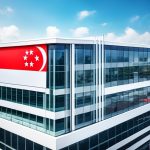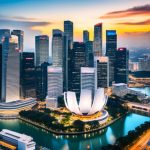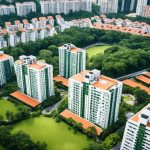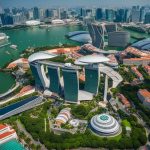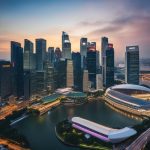Did you know that over 80% of Singapore’s population resides in public housing? It’s an astounding statistic that highlights the immense scale and impact of Singapore’s housing system. In this article, we will delve into the unique policies and initiatives that shape urban living in Singapore and provide affordable housing options for its residents.
Key Takeaways
- Singapore’s housing system is characterized by a high percentage of public housing, with over 80% of the population living in these affordable homes.
- The Housing Development Board (HDB) plays a crucial role in providing public housing options through various schemes like the Build-To-Order (BTO) scheme.
- Private properties, including condominiums and landed properties, form a significant part of the housing market in Singapore.
- The Singaporean government has implemented measures to ensure affordable housing options for low-income residents.
- Sustainable housing practices and urban planning strategies are prioritized to create a greener and more livable city.
Singapore’s Housing Policies
As a city-state with limited land resources, Singapore has implemented a range of housing policies to ensure affordable and accessible housing for its citizens. These policies, developed and implemented by the Singaporean government, aim to address the unique challenges of urban living and create a sustainable and inclusive housing system.
Through strategic planning and a proactive approach, Singapore has become a global leader in urban housing development. Let’s explore some of the key housing policies that have shaped the city-state’s housing landscape.
1. Central Provident Fund (CPF) Housing Grants
The Singaporean government provides housing grants through the Central Provident Fund (CPF) to assist eligible citizens in purchasing their first homes. These grants, such as the Enhanced CPF Housing Grant (EHG) and the Family Grant, offer financial support to lower-income households and encourage homeownership.
2. Public Housing Development
A cornerstone of Singapore’s housing policies is the development of public housing, known as Housing Development Board (HDB) flats. The government constructs and sells these affordable homes to Singaporean citizens at subsidized prices. Public housing estates are well-planned and equipped with amenities such as schools, parks, and transportation facilities, ensuring a cohesive and vibrant community.
3. Ethnic Integration Policy (EIP) and Singapore Permanent Resident (SPR) Quota
To promote racial harmony and social integration, the government implemented the Ethnic Integration Policy (EIP) and the Singapore Permanent Resident (SPR) Quota. These policies prevent the formation of racial enclaves and ensure a balanced mix of ethnic groups within public housing neighborhoods.
4. Build-To-Order (BTO) Scheme
The Build-To-Order (BTO) scheme offers newly constructed HDB flats to eligible Singaporean citizens at subsidized prices. Through this scheme, the government allocates land for development and invites citizens to apply for new flats in desired locations. This encourages homeownership and helps address the demand for affordable housing.
5. Rental Flat Schemes
For citizens who may not be ready or eligible to purchase a home, Singapore offers Rental Flat Schemes, providing affordable rental housing options. These schemes cater to different needs, including rental flats for lower-income households and executive condominiums for middle-income families.
6. Affordable Home Ownership Program (AHOP)
Under the Affordable Home Ownership Program (AHOP), the government collaborates with private developers to offer affordable housing options to Singaporean households. This program aims to provide affordable ownership opportunities for families who do not qualify for public housing or require alternative housing solutions.
| Housing Policy | Description |
|---|---|
| Central Provident Fund (CPF) Housing Grants | Financial grants to assist first-time homebuyers. |
| Public Housing Development | Construction and sale of affordable Housing Development Board (HDB) flats. |
| Ethnic Integration Policy (EIP) and Singapore Permanent Resident (SPR) Quota | Policies to promote racial harmony and prevent ethnic enclaves. |
| Build-To-Order (BTO) Scheme | Offering newly constructed HDB flats at subsidized prices. |
| Rental Flat Schemes | Affordable rental housing options for different income groups. |
| Affordable Home Ownership Program (AHOP) | Collaboration with private developers to offer affordable housing options. |
Public Housing in Singapore
In Singapore, the provision of affordable housing is a top priority for the government. The public housing scheme, known as the Housing Development Board (HDB), plays a crucial role in ensuring that Singaporeans have access to safe and affordable homes.
The HDB was established in 1960 with the aim of addressing the housing shortages and overcrowding issues faced by Singapore at that time. Today, more than 80% of Singapore’s population resides in HDB flats, making it a fundamental part of the country’s housing landscape.
The HDB’s primary objective is to provide affordable housing options for Singaporean citizens, making home ownership a reality for many. Through various housing programs and initiatives, the HDB offers a wide range of flats that cater to different budgets and needs.
One of the key features of public housing in Singapore is the leasehold tenure system. Instead of owning the land on which the flats are built, residents hold a 99-year lease on the property. This system allows the government to maintain control over land use and ensures that housing remains affordable and accessible to future generations.
The Role of the HDB
The HDB is responsible for the planning, construction, and management of public housing estates in Singapore. This includes the development of new towns, the upgrading of existing estates, and the provision of essential amenities and facilities within these communities.
Furthermore, the HDB plays a vital role in promoting social cohesion and community bonding. The design of HDB estates encourages social interactions through the provision of common spaces, recreational facilities, and community centers. This creates a sense of belonging and fosters a strong community spirit among residents.
“The HDB has been instrumental in improving the quality of life for Singaporeans by providing affordable and well-designed homes. It has transformed the housing landscape of Singapore and continues to play a pivotal role in shaping the country’s urban environment.”
The success of the public housing scheme can be attributed to the HDB’s commitment to maintaining high standards of construction, design, and urban planning. Strict guidelines and regulations ensure that HDB flats are built to meet the needs of residents while adhering to sustainable practices and promoting a desirable living environment.
To illustrate the impact of public housing on the lives of Singaporeans, here is a table showcasing a few key statistics:
| Statistic | Value |
|---|---|
| Percentage of Singaporeans residing in HDB flats | 80% |
| Average waiting time for a new HDB flat | 3-4 years |
| Percentage of residents satisfied with their HDB housing | 90% |
Public housing in Singapore has not only provided a roof over the heads of its residents but has also fostered a sense of pride and stability within the community. The HDB’s relentless efforts towards affordability, sustainability, and community-building have made Singapore’s public housing system a global benchmark.
HDB Flats
When it comes to affordable housing in Singapore, HDB flats play a crucial role in meeting the housing needs of its residents. HDB, which stands for Housing Development Board, is responsible for the planning and development of public housing in the country. These flats provide a comfortable and affordable housing option for Singaporeans, ensuring that everyone has access to a decent place to live.
HDB offers a variety of flat types to cater to different household sizes and preferences. Whether you’re a single individual or a multi-generational family, there’s likely a suitable HDB flat for you. Here are some of the common types of HDB flats available:
| Type of HDB Flat | Description |
|---|---|
| 1-room | Compact flats designed for singles or couples |
| 2-room | Slightly larger flats suitable for small families |
| 3-room | Standard flats with three bedrooms |
| 4-room | Fairly spacious flats ideal for medium-sized families |
| 5-room | Generously-sized flats suitable for larger families |
| Executive | Luxurious flats equipped with added features like a study room or balcony |
To be eligible to purchase or rent an HDB flat, applicants must be Singapore Citizens or Permanent Residents above the age of 21. They should also meet the prevailing eligibility conditions set by HDB, which include income ceilings and ownership restrictions. These eligibility criteria aim to ensure that HDB flats are allocated to those who truly need them and to maintain the affordability of the public housing system.
If you’re considering HDB flats as your housing option in Singapore, it’s important to understand the different types available and the eligibility criteria involved. Whether you’re a single professional or a growing family, there’s an HDB flat that suits your needs.
BTO Scheme
One of the key initiatives in Singapore’s housing system is the Build-To-Order (BTO) scheme. This scheme provides Singaporean citizens with the opportunity to apply for newly constructed HDB flats at subsidized prices, making homeownership more accessible for many.
The BTO scheme offers a range of benefits for prospective homeowners. Firstly, it allows individuals and families to purchase a brand new HDB flat, ensuring that they receive properties built with modern infrastructure and design. Furthermore, BTO flats are often located in well-planned housing estates, complete with amenities such as parks, community centers, and schools, providing residents with a comfortable and convenient living environment.
To apply for a BTO flat, eligible Singaporeans can submit their applications during specific sales launches. The application process is conducted online through the HDB portal, making it efficient and user-friendly. Applicants have the flexibility to choose from various flat types and locations, enabling them to select a property that suits their preferences and needs.
Once the application period is closed, the flats are built based on the demand and location preferences of the applicants. The construction process typically takes a few years, during which the applicants are regularly updated on the progress of their flat. Upon completion, successful applicants will be able to collect the keys to their new home and begin their homeownership journey.
The BTO scheme has proven to be highly popular among Singaporeans, with thousands of applicants vying for the limited number of flats available during each sales launch. The scheme’s attractiveness lies in its affordability and the opportunity it provides for young families to own their homes without incurring excessive financial burdens. This not only contributes to social stability but also encourages a sense of pride and ownership among homeowners.
The BTO scheme has played a significant role in shaping the housing landscape in Singapore, providing affordable and quality homes to countless individuals and families. It demonstrates the government’s commitment to ensuring that every Singaporean has access to secure and comfortable housing, contributing to the overall well-being and prosperity of the nation.
| BTO Scheme Benefits | Application Process |
|---|---|
|
|
Rental Housing Options
If you’re looking for rental housing options in Singapore, you’ll be pleased to know that there are various choices available to suit different preferences and budgets. Whether you’re a young professional, a small family, or an expatriate, Singapore offers a range of rental flats, executive condominiums, and private rental properties.
Rental Flats
Rental flats, also known as public rental flats, are managed by Singapore’s Housing and Development Board (HDB). These flats are a popular choice for locals and permanent residents who are not yet eligible to purchase a flat or prefer the flexibility of renting. Rental flats are available in different housing estates across the island and are subject to income eligibility criteria.
Executive Condominiums
Executive condominiums, or ECs, are a hybrid of public and private housing. They are developed and sold by private developers but come with certain eligibility conditions imposed by the government. ECs offer more spacious units and a range of facilities such as swimming pools, gyms, and playgrounds, making them an attractive option for families.
Private Rental Properties
For those who prefer a more exclusive and customizable living experience, private rental properties are available in various forms, including condominiums, apartments, and landed houses. These properties are owned by private landlords and offer a greater degree of luxury and privacy. Rental prices for private properties vary depending on location, size, and amenities.
If you’re undecided on which rental housing option is right for you, take some time to consider your needs, preferences, and budget. Research the different neighborhoods and their amenities, and weigh the pros and cons of each option. It’s also a good idea to seek advice from a professional real estate agent who can guide you through the rental process and help you find the perfect home.
| Rental Housing Options | Features |
|---|---|
| Rental Flats | – Managed by HDB – Income eligibility criteria – Located across different housing estates |
| Executive Condominiums | – Developed by private developers with government eligibility criteria – Spacious units – Facilities like swimming pools and gyms |
| Private Rental Properties | – Condominiums, apartments, and landed houses – Owned by private landlords – Luxury and privacy |
Financing Options for Housing
When it comes to purchasing or renting a home in Singapore, there are various financing options and schemes available to help Singaporeans fulfill their housing dreams. Whether you are a first-time buyer or looking to upgrade to a larger property, understanding these financing options can make the process smoother and more affordable.
Affordable Housing Grant
One of the financing options available is the Affordable Housing Grant, which provides financial assistance to eligible individuals or families to purchase their first home or upgrade to a larger flat. The grant amount varies depending on the income and household size, providing an additional boost to make homeownership more attainable.
HDB Home Loans
For those looking to buy a HDB flat, HDB offers fixed-rate loans to qualified buyers. These loans have competitive interest rates and flexible repayment options, making it easier for Singaporeans to finance their home purchases. Additionally, HDB offers the Enhanced Central Provident Fund (CPF) Housing Grant, which provides further assistance to first-time buyers.
Bank Loans
Beyond HDB loans, homebuyers can also consider obtaining a bank loan for their property purchase. Banks in Singapore offer a range of home loan packages with varying interest rates and terms. Potential buyers can compare different banks and their offerings to find the most suitable loan for their needs. It is important to consider factors such as interest rates, loan tenure, and down payment requirements when exploring bank loan options.
Rental Assistance Schemes
In addition to financing options for purchasing a home, there are also rental assistance schemes available for those who prefer to rent. The government provides assistance to low-income households through schemes such as the Public Rental Scheme and the Rent-to-own Scheme. These schemes aim to provide affordable rental options and support families in their housing journey.
Central Provident Fund (CPF) Usage
Singaporeans can also tap into their Central Provident Fund (CPF) savings to finance their housing needs. The CPF can be used for down payments, monthly mortgage repayments, and even to purchase property under certain conditions. Utilizing CPF savings can ease the financial burden of homeownership and provide a flexible financing option to Singaporeans.
It is important for prospective homeowners to carefully assess their financial situation and explore different financing options available to make informed decisions. Consulting with financial advisors or engaging the services of real estate professionals can provide additional guidance in navigating these financing options for housing.
| Financing Option | Description |
|---|---|
| Affordable Housing Grant | Provides financial assistance to eligible individuals or families for purchasing their first home or upgrading to a larger flat. |
| HDB Home Loans | Offers fixed-rate loans with competitive interest rates and flexible repayment options for purchasing HDB flats. |
| Bank Loans | Allows homebuyers to obtain loans from banks with different interest rates and terms. |
| Rental Assistance Schemes | Provides rental assistance to low-income households through schemes like the Public Rental Scheme and Rent-to-own Scheme. |
| Central Provident Fund (CPF) Usage | Allows Singaporeans to use their CPF savings for housing-related expenses such as down payments and mortgage repayments. |
Private Property Market
In Singapore’s bustling real estate landscape, the private property market plays a significant role in offering a diverse range of housing options to residents. From luxurious condominiums to spacious landed properties, the private property market caters to those seeking exclusivity, comfort, and prestige.
Condominiums stand tall as iconic symbols of modern urban living in Singapore. These high-rise developments offer a range of facilities and amenities, including swimming pools, gyms, and landscaped gardens, providing residents with a lavish lifestyle amidst the city’s vibrant energy.
Landed properties, on the other hand, offer spaciousness and privacy that many desire. From detached houses to terrace houses and semi-detached houses, these properties provide ample space for families to grow and create lasting memories.
Private Property Prices
The private property market in Singapore is known for its dynamic nature, influenced by factors such as location, property size, and market demand. As of 2021, the average price of a non-landed private residential property in Singapore is approximately £1.5 million. Condominium prices vary depending on various factors such as location, size, and amenities, ranging from £1 million to £10 million or more.
| Property Type | Average Price (2021) |
|---|---|
| Condominiums | £1 million to £10 million+ |
| Landed Properties | £5 million to £30 million+ |
Note: Prices mentioned are approximate and subject to change depending on market conditions and property specifications.
Investing in the private property market provides potential returns in the form of capital appreciation and rental income. However, it is essential for buyers to assess their financial capacity and consider factors such as mortgage loans, down payments, and maintenance costs before making a purchase.
Investing in a private property offers more than just a home; it represents a sound investment with the potential for long-term financial growth. However, it requires careful consideration and financial planning to ensure a successful venture.
As the private property market continues to evolve alongside Singapore’s growing urban landscape, both local and foreign buyers have a wide array of options to choose from. The diverse range of properties available caters to different preferences and lifestyles, making the private property market an integral part of Singapore’s real estate industry.
Buying a Private Property
When it comes to purchasing a private property in Singapore, buyers need to navigate through a process that involves certain costs and legal requirements. Whether you are a Singaporean citizen or a foreign investor, understanding the steps involved can help you make informed decisions.
Firstly, it is important to identify the property that meets your needs and preferences. This can be done by browsing through various property listings or engaging the services of a real estate agent who specializes in private properties. Once you have found a property that interests you, the next step is to conduct a thorough inspection to ensure that it meets your expectations.
After selecting the property, the next step is to make an offer to the seller. This involves negotiating the price and terms of the sale. It is recommended to seek legal advice during this stage to ensure that the agreement is fair and complies with all legal requirements.
Once the purchase price and terms have been agreed upon, the buyer and seller will enter into a Sales and Purchase Agreement (SPA). This legally binding document outlines the details of the transaction, including the purchase price, payment terms, and other clauses. It is crucial for both parties to carefully review and understand the contents of the SPA before signing it.
Following the execution of the SPA, the buyer is required to pay a deposit, typically 5% to 10% of the purchase price, to secure the property. The deposit is usually held by a stakeholder, such as the buyer’s lawyer or a trusted third party, until the completion of the sale.
Subsequently, the buyer will engage a lawyer to conduct a title search and verify the legal status of the property. The lawyer will also assist in preparing the necessary documents for the transfer of ownership, such as the Transfer of Property and Mortgage documents.
On the completion date, the buyer is required to pay the balance of the purchase price and all applicable fees, including stamp duty and legal fees. Upon receipt of payment, the seller will transfer the ownership of the property to the buyer, and the transaction is deemed complete.
It is worth noting that buying a private property in Singapore involves additional costs, such as stamp duty, legal fees, and property tax. These expenses should be taken into account when considering your budget and affordability.
In summary, buying a private property in Singapore requires careful consideration, thorough inspections, and legal assistance. Understanding the process and associated costs is essential to ensure a smooth and successful transaction.
Summary
Buying a private property in Singapore:
- Involves browsing property listings or engaging a real estate agent
- Requires thorough property inspections
- Entails negotiation and agreement on price and terms
- Involves the signing of a Sales and Purchase Agreement (SPA)
- Requires payment of a deposit to secure the property
- Involves legal verification and preparation of transfer documents
- Requires payment of the balance purchase price and applicable fees on the completion date
- Involves additional costs such as stamp duty, legal fees, and property tax
Affordable Housing for Low-Income Residents
One of the key priorities of the Singaporean government is to ensure affordable housing for low-income residents. Through a range of measures and schemes, the government aims to provide housing options that cater to the needs and financial capabilities of this vulnerable segment of the population.
1. Rental Housing Assistance
One of the primary initiatives is the rental housing assistance program. This scheme offers subsidized rental rates for low-income individuals and families, enabling them to live in decent homes without excessive financial burden. The government works closely with various agencies to administer this program effectively and ensure that those in need are provided with appropriate housing.
2. Public Housing Rental Scheme
Another avenue for low-income residents to access affordable housing is through the Public Housing Rental Scheme. Under this scheme, individuals and families can rent HDB flats at significantly discounted rates. The Housing Development Board (HDB) facilitates this program, offering a range of rental options to cater to different household sizes and needs.
3. Home Ownership Assistance
In addition to rental options, the government also provides assistance in homeownership for low-income residents. Through various grants and subsidies, eligible individuals and families can purchase their own homes at affordable prices. The Enhanced CPF Housing Grant and the Special CPF Housing Grant are examples of financial aid schemes designed to make homeownership more accessible for low-income households.
| Government Program | Description |
|---|---|
| Rental Housing Assistance | Subsidized rental rates for low-income individuals and families |
| Public Housing Rental Scheme | Offers discounted rental rates for HDB flats |
| Home Ownership Assistance | Grants and subsidies to facilitate affordable homeownership |
These measures ensure that low-income residents have the opportunity to live in secure and comfortable homes, fostering a sense of stability and well-being within the community. The Singaporean government continues to review and enhance these initiatives to meet the evolving needs of its citizens and ensure that affordable housing remains a top priority.
Providing affordable housing for low-income residents not only addresses an immediate need but also contributes to social cohesion and sustainable urban development. By creating an inclusive society where no one is left behind, Singapore sets an example for other nations facing similar housing challenges.
Housing Amenities and Facilities
When it comes to housing in Singapore, residents can expect more than just a roof over their heads. The city-state takes pride in offering a wide range of amenities and facilities within its public and private housing developments. From parks and schools to healthcare facilities, these amenities enhance the quality of life for residents and create vibrant and self-sufficient communities.
One of the standout features of public housing in Singapore is the inclusion of spacious and well-maintained parks. These green spaces offer a serene environment for residents to relax, exercise, and connect with nature. With meticulously landscaped gardens, jogging paths, and playgrounds, these parks provide opportunities for individuals and families to engage in recreational activities and foster a sense of community.
Furthermore, the housing developments in Singapore are strategically located within close proximity to educational institutions. Residents have access to a range of schools, from primary to tertiary levels, ensuring that their children can receive quality education without having to travel long distances.
Healthcare facilities are also conveniently located near housing precincts, ensuring that residents have easy access to medical services. From polyclinics to specialist hospitals, these healthcare facilities offer comprehensive healthcare services to cater to the needs of residents of all ages.
In addition to parks, schools, and healthcare facilities, housing developments in Singapore also incorporate essential amenities such as supermarkets, food centers, and community centers. These amenities provide convenience and foster a strong sense of community cohesion.
Facilities in Singapore’s Housing Developments
| Facility | Description |
|---|---|
| Parks | Spacious green spaces with well-maintained gardens, jogging paths, and playgrounds. |
| Schools | A wide range of educational institutions, from primary to tertiary levels. |
| Healthcare Facilities | Polyclinics, specialist hospitals, and medical centers conveniently located near housing precincts. |
| Supermarkets | Convenient access to grocery stores within housing developments. |
| Food Centers | Offering a variety of affordable and delicious local food options. |
| Community Centers | Spaces for residents to engage in recreational activities, workshops, and community events. |
These amenities and facilities not only enhance the overall living experience but also contribute to the social fabric of the community. They encourage residents to lead active and healthy lifestyles, foster strong community bonds, and create a sense of belonging.
Urban Planning and Sustainable Housing
Singapore’s commitment to urban planning and sustainable housing has made it a global leader in creating environmentally-friendly and livable cities. The city-state has implemented innovative strategies and initiatives to ensure that urban development is balanced with environmental preservation and sustainable practices.
Making Singapore Green
One of the key aspects of Singapore’s urban planning is the integration of green spaces and parks throughout the city. With more than 300 parks and four nature reserves, Singapore prioritizes greenery to enhance the quality of life for its residents. These green spaces not only provide recreational areas but also contribute to improving air quality and mitigating urban heat island effects.
In addition to parks, Singapore incorporates sustainable housing practices into the design and construction of buildings. The city-state embraces energy-efficient technologies, such as green building materials, solar panels, and rainwater harvesting systems, to reduce carbon emissions and optimize resource utilization. The use of sustainable materials and design principles also helps to create healthier and more comfortable living environments for residents.
Creating Sustainable Neighborhoods
Another significant aspect of Singapore’s urban planning is the development of sustainable neighborhoods. These neighborhoods are designed to be self-sufficient, with easy access to essential amenities and services. Residents within these neighborhoods can meet their daily needs close to home, reducing the reliance on cars and promoting sustainable modes of transportation.
| Feature | Description |
|---|---|
| Cycling Infrastructure | Well-connected cycling paths and bicycle-sharing schemes encourage residents to use bicycles for short-distance commuting. |
| Integrated Transport Hubs | Integrated transport hubs, such as MRT stations and bus interchanges, provide convenient access to public transportation. |
| Mixed-Use Developments | Neighborhoods incorporate mixed-use developments, combining residential, commercial, and recreational spaces to reduce commuting distances. |
| Community Gardens | Community gardens promote urban farming and community bonding, while also reducing food miles and encouraging sustainable practices. |
By implementing these sustainable practices and creating well-planned neighborhoods, Singapore aims to enhance the overall quality of life for its residents, while also reducing the city’s ecological footprint and preserving natural resources for future generations.
“Singapore’s urban planning strategies demonstrate a holistic approach to sustainable development, creating a harmonious balance between economic growth, environmental preservation, and social well-being.”
With its relentless focus on urban planning and sustainable housing, Singapore continues to set an example for cities around the world. Through these efforts, the city-state remains committed to creating a greener, more livable environment for its residents while ensuring long-term sustainability.
Challenges in the Housing System
Despite the success and efficiency of Singapore’s housing system, it is not without its fair share of challenges. These challenges stem from various factors such as rising property prices, limited land availability, and the increasing demand for affordable housing. Addressing these challenges is crucial to ensuring a sustainable and inclusive housing system for all Singaporeans.
Rising Property Prices
One of the significant challenges in the Singaporean housing system is the continuous increase in property prices. The demand for housing, coupled with limited land supply, has led to soaring property prices, making homeownership increasingly unaffordable for many. This trend poses a barrier to entry in the property market, particularly for first-time buyers and low-income households.
Limited Land Availability
Singapore’s small land size presents a unique challenge in meeting the growing housing needs of its population. With limited land available for residential development, there is a constant pressure to maximize land use efficiently. Urban planners face the important task of balancing housing demands with other essential infrastructure, green spaces, and amenities.
Demand for Affordable Housing
The demand for affordable housing remains high in Singapore, with a significant portion of the population relying on public housing options. While the government has implemented initiatives to provide affordable housing, the surging demand often exceeds the supply, creating a gap in meeting the needs of lower-income households. This challenge calls for innovative approaches to increase the availability and accessibility of affordable housing options.
“The limited land availability in Singapore poses a challenge in meeting the housing demands of a growing population.”
Overcoming these challenges requires a comprehensive and adaptive approach that considers the social, economic, and environmental aspects of housing. The government continues to explore strategies, such as land reclamation, urban redevelopment, and the development of new towns, to tackle these housing challenges effectively. By prioritizing affordability, sustainability, and inclusivity, Singapore aims to provide its residents with quality homes and an enhanced living environment.
Stay tuned for the next section as we delve into the future of Singapore’s housing system and explore potential developments and innovations in meeting the evolving needs of its residents.
Future of Singapore’s Housing System
The future of Singapore’s housing system holds promising developments and innovative solutions to address the evolving needs and aspirations of its residents. As the population continues to grow and urbanization progresses, the Singaporean government remains committed to providing affordable and quality housing for all.
Smart and Sustainable Homes
One of the key focuses in the future of Singapore’s housing system is the integration of smart and sustainable technologies. With the rapid advancements in technology, homes are becoming more connected and energy-efficient, promoting a greener and more sustainable living environment. From smart home automation systems that enhance convenience and energy management to initiatives that encourage the use of renewable energy sources, the future housing landscape in Singapore will prioritize sustainability and efficiency.
Mixed-Use Developments
In line with urban planning strategies, future housing developments in Singapore are expected to incorporate mixed-use elements. This concept allows residents to live, work, and play within the same neighborhood, reducing the need for long commutes and enhancing the overall quality of life. Mixed-use developments often feature a blend of residential, commercial, and recreational spaces, creating vibrant and self-sustaining communities.
Flexible and Adaptable Spaces
The future of Singapore’s housing system recognizes the importance of adapting to changing circumstances and demographics. Homes will be designed with flexible spaces that can be easily reconfigured to suit residents’ evolving needs. This approach allows for efficient use of space and ensures that homes can accommodate different family sizes and lifestyles. With the flexibility to transform spaces, residents can create personalized environments that cater to their unique preferences and requirements.
Community-Driven Initiatives
Community involvement and participation are key drivers of the future housing system in Singapore. The government will continue to encourage the formation of strong and cohesive communities by providing spaces and amenities that foster social interaction and engagement. Community gardens, shared facilities, and common spaces will create opportunities for residents to connect, collaborate, and build meaningful relationships with their neighbors.
The future of Singapore’s housing system is anchored in the principles of affordability, sustainability, and community building. Through innovative approaches and forward-thinking policies, Singapore aims to create a housing landscape that enriches the lives of its residents and ensures a thriving and inclusive future for generations to come.
Conclusion
In conclusion, the housing system in Singapore plays a crucial role in shaping urban living for its residents. Through a combination of innovative policies, such as the public housing scheme and the Build-To-Order (BTO) scheme, the Singaporean government has successfully provided affordable housing options for its citizens. The Housing Development Board (HDB) offers a wide range of HDB flats, catering to different needs and eligibility criteria.
Not only does Singapore provide affordable housing, but it also offers various financing options to assist residents in purchasing or renting their homes. The private property market, including condominiums and landed properties, provides a diverse range of choices for those who seek alternative housing options. Furthermore, the government’s commitment to affordable housing for low-income residents ensures that everyone has access to suitable and comfortable homes.
The housing system in Singapore is not just about providing shelter; it is about creating vibrant and sustainable communities. The amenities and facilities integrated into public and private housing developments, such as parks, schools, and healthcare facilities, enhance the quality of life for residents. Singapore’s urban planning strategies emphasize sustainability, incorporating green initiatives and sustainable housing practices to create a greener and more livable city.
Although challenges exist, such as rising property prices and limited land availability, Singapore continues to adapt and innovate its housing system to meet the evolving needs of its residents. The future of Singapore’s housing system holds great potential for further development and innovations that will continue to shape urban living for generations to come.
FAQ
Q: What is the housing system in Singapore?
A: The housing system in Singapore refers to the policies and programs implemented by the government to ensure affordable and quality housing for its residents.
Q: What are Singapore’s housing policies?
A: Singapore’s housing policies encompass a range of measures that aim to provide affordable housing for its citizens, including the regulation of housing prices, subsidies for first-time buyers, and the development of public housing estates.
Q: What is public housing in Singapore?
A: Public housing in Singapore is primarily provided by the Housing Development Board (HDB). It offers affordable housing options for Singaporeans through the construction and management of public housing estates across the country.
Q: What are HDB flats?
A: HDB flats are public housing units offered by the Housing Development Board (HDB) in Singapore. They come in different types and sizes, ranging from studio apartments to larger family flats, and are available for purchase or rental by eligible Singaporeans.
Q: What is the BTO scheme in Singapore?
A: The Build-To-Order (BTO) scheme is a housing program in Singapore that allows eligible Singaporeans to apply for newly constructed HDB flats at subsidized prices. Applicants can choose the location and flat type based on their preferences.
Q: What rental housing options are available in Singapore?
A: Singapore offers various rental housing options, including rental flats managed by the Housing Development Board (HDB), executive condominiums, and private rental properties offered by landlords or property management companies.
Q: What financing options are available for housing in Singapore?
A: Singaporeans have access to a range of financing options for housing, such as housing loans from banks and financial institutions, the Central Provident Fund (CPF) housing grants, and the Home Protection Scheme for mortgage insurance.
Q: What is the private property market in Singapore?
A: The private property market in Singapore refers to privately-owned residential properties, including condominiums and landed houses. These properties are typically more expensive than HDB flats and offer additional amenities and facilities.
Q: How can I buy a private property in Singapore?
A: Buying a private property in Singapore involves several steps, including engaging a property agent, arranging for financing, conducting property inspections, and submitting the necessary documents and fees to complete the purchase.
Q: How does Singapore provide affordable housing for low-income residents?
A: The Singaporean government implements various measures to ensure low-income residents have access to affordable housing, such as rental housing subsidies, financial assistance schemes, and public rental flats managed by the Housing Development Board (HDB).
Q: What amenities and facilities are available in Singapore’s housing developments?
A: Singapore’s housing developments offer a wide range of amenities and facilities, including parks, playgrounds, community centers, schools, healthcare facilities, shopping malls, and transportation links to ensure residents enjoy a convenient and comfortable living environment.
Q: How does Singapore incorporate sustainable housing practices?
A: Singapore’s urban planning strategies prioritize sustainability and environmentally-friendly practices in the design and construction of housing developments. These include the integration of green spaces, energy-efficient building technologies, and the promotion of sustainable transportation options.
Q: What are the challenges in Singapore’s housing system?
A: Singapore’s housing system faces challenges such as rising property prices, limited land availability, and the increasing demand for affordable housing. The government continually addresses these challenges through policy adjustments and long-term planning.
Q: What does the future hold for Singapore’s housing system?
A: The future of Singapore’s housing system may involve innovations in design and technology, increased focus on sustainability, and the development of new housing models to meet the evolving needs and aspirations of Singapore’s residents.






